34 Types of Stapelia Succulents (With Pictures)
Are you searching for a unique and visually stunning addition to your garden? Look no further than Stapelia succulents! With their low-growing, perennial nature and a wide range of colors including pink, purple, green, and red, these plants are sure to captivate your attention. Originating from South Africa, Stapelia succulents are known for their magnificent, star-shaped flowers that add a touch of magic to any space. Prepare to be amazed as we delve into the world of different Stapelia varieties, exploring their origins, vibrant colors, and the sheer beauty of their big, beautiful flowers.
Contents
- 1 Types of Stapelia
- 2 Stapelia Species and Varieties
- 2.1 Stapelia clavicorona
- 2.2 Stapelia divaricata
- 2.3 Stapelia engleriana
- 2.4 Stapelia flavopurpurea
- 2.5 Stapelia gariepensis
- 2.6 Stapelia gettleffii
- 2.7 Stapelia gigantea
- 2.8 Stapelia glanduliflora
- 2.9 Stapelia grandiflora
- 2.10 Stapelia hirsuta
- 2.11 Stapelia leendertziae
- 2.12 Stapelia mutabilis
- 2.13 Stapelia obducta
- 2.14 Stapelia olivacea
- 2.15 Stapelia paniculata
- 2.16 Stapelia rufa
- 2.17 Stapelia schinzii
- 2.18 Stapelia similis
- 2.19 Stapelia unicornis
- 2.20 Stapelia villetiae
- 3 How to Care for Stapelia
- 4 How to Propagate Stapelia?
- 5 FAQs
Types of Stapelia
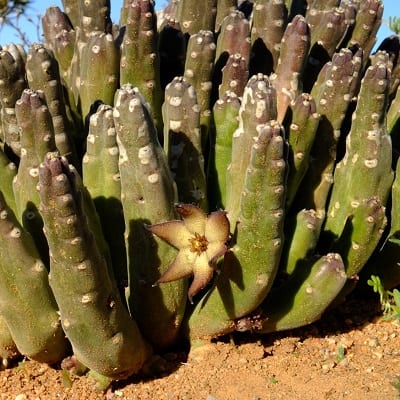
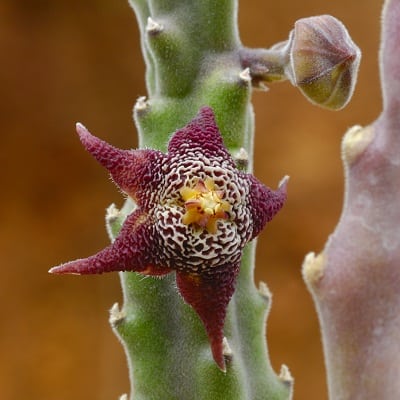
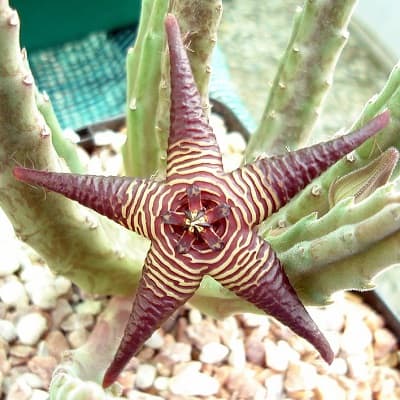
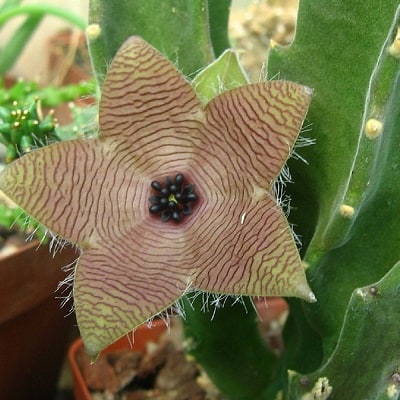
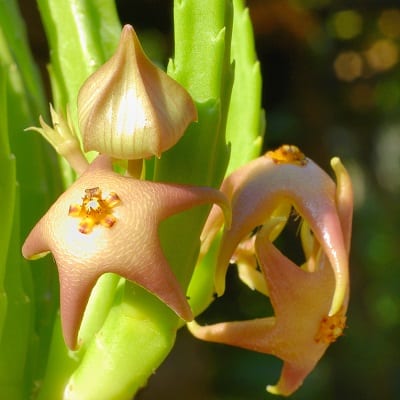
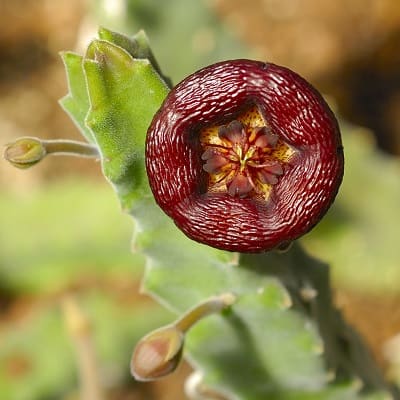
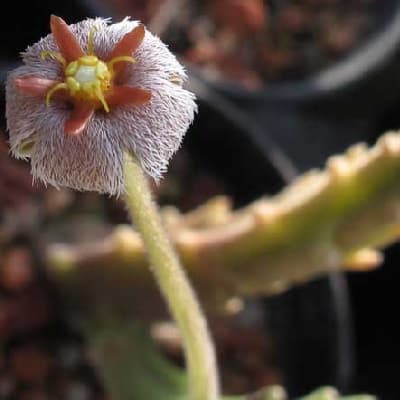
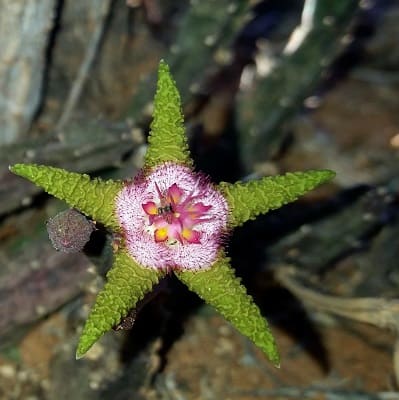
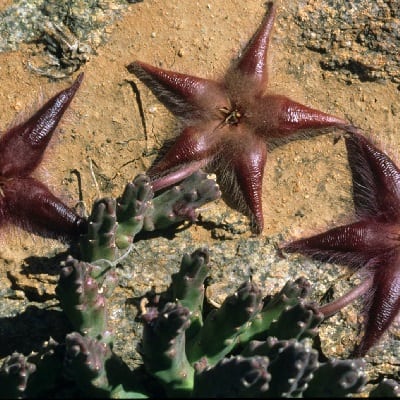
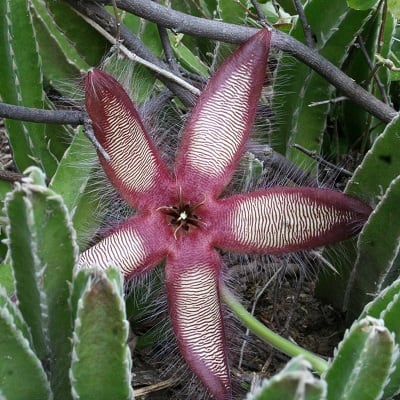
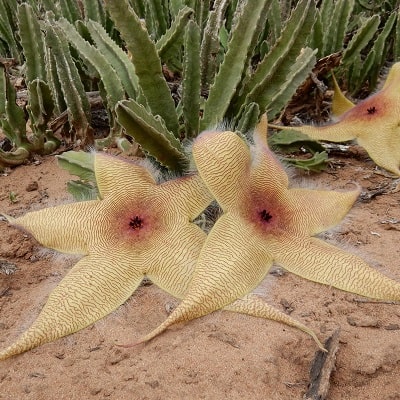
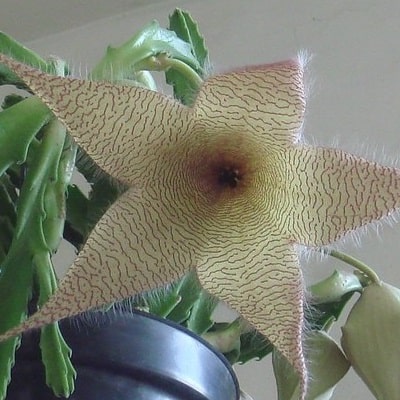
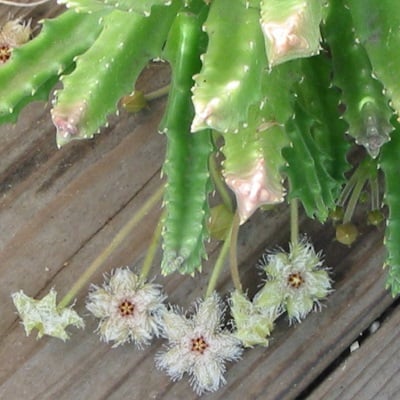
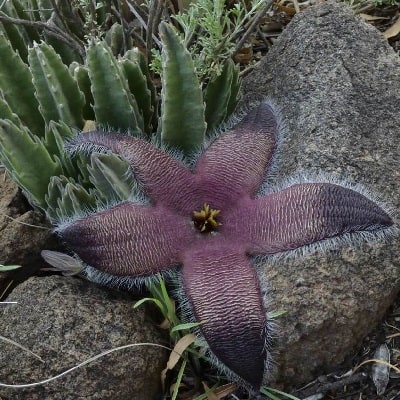
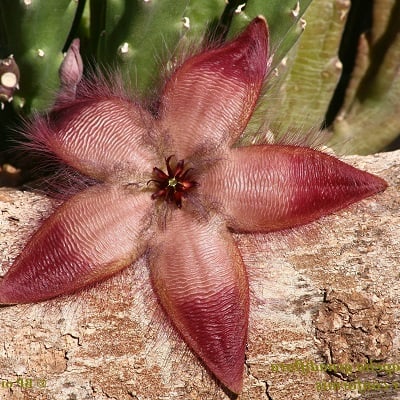
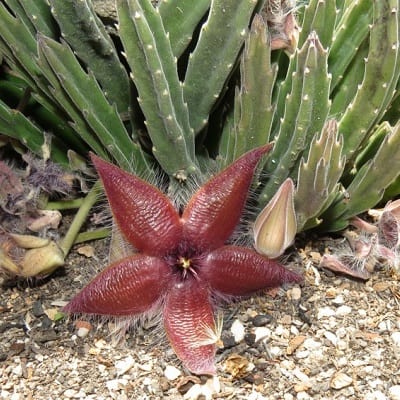
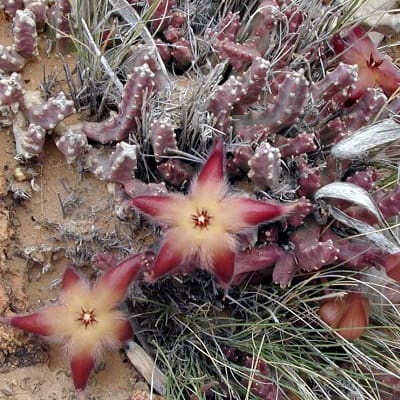
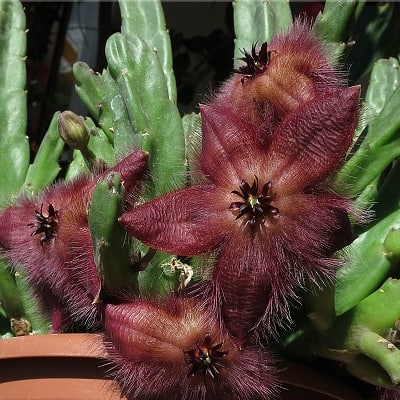
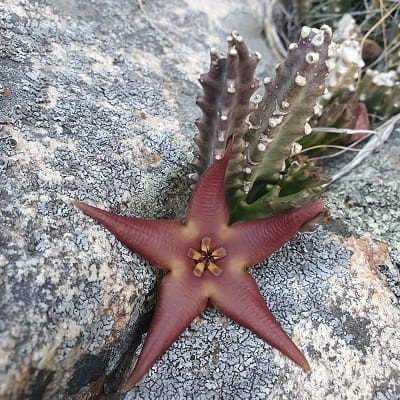
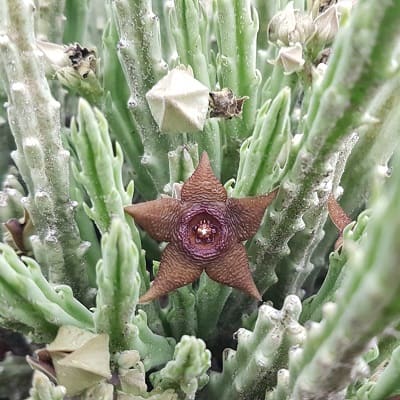
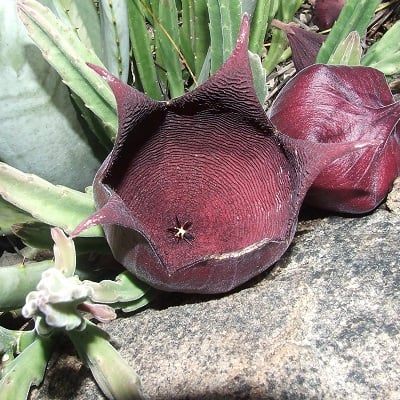
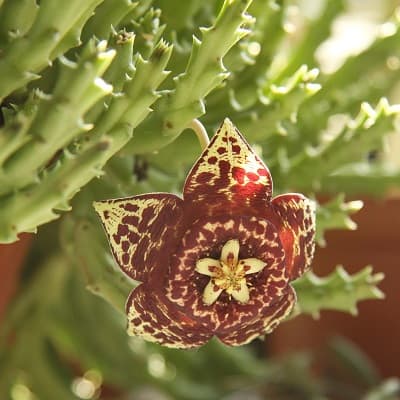
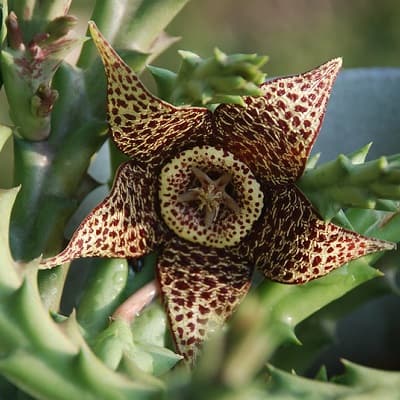
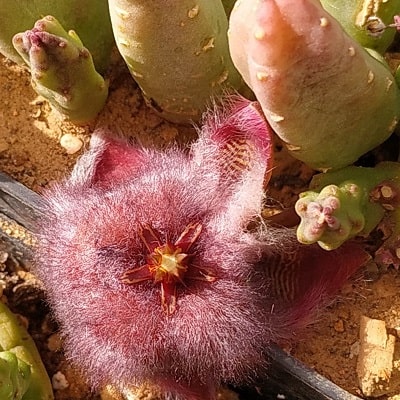
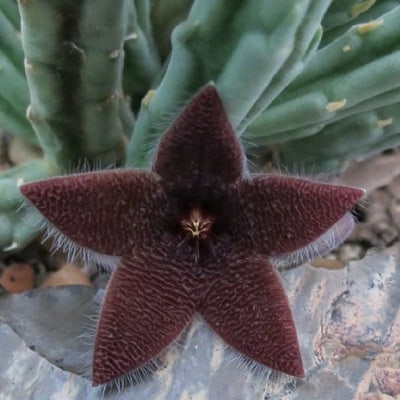
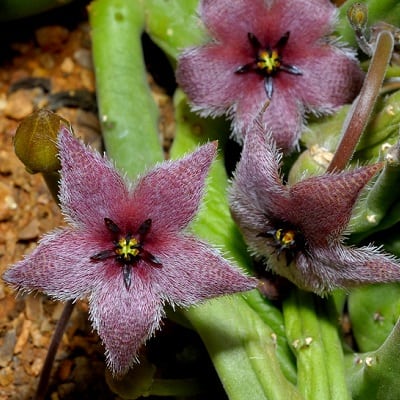
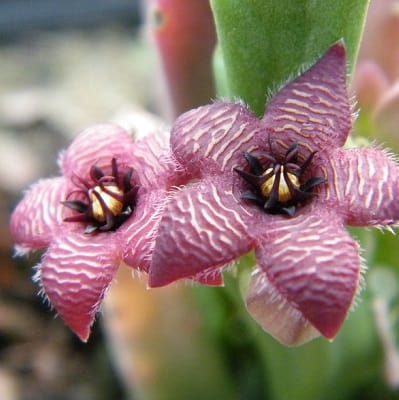
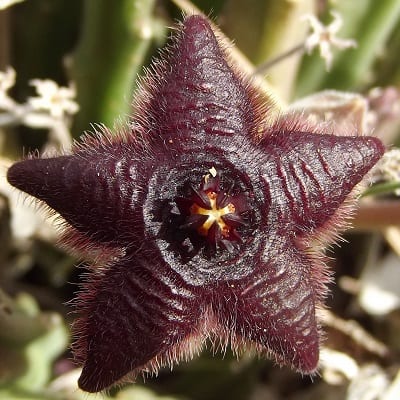
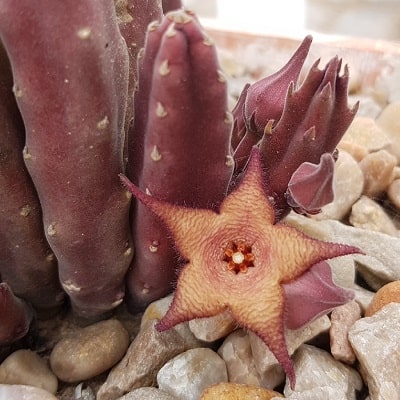
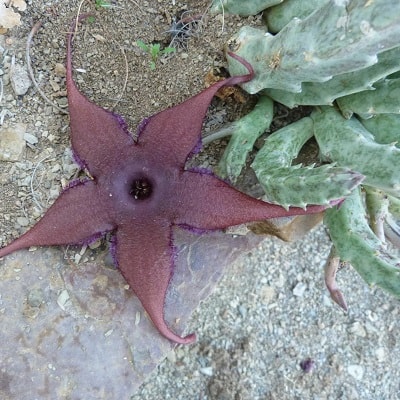
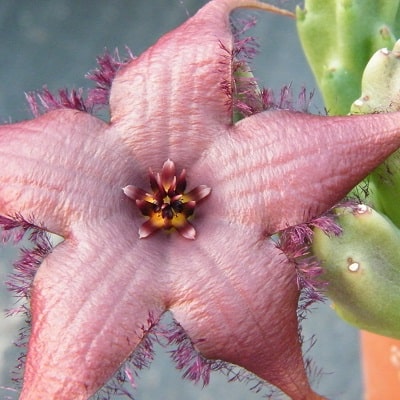
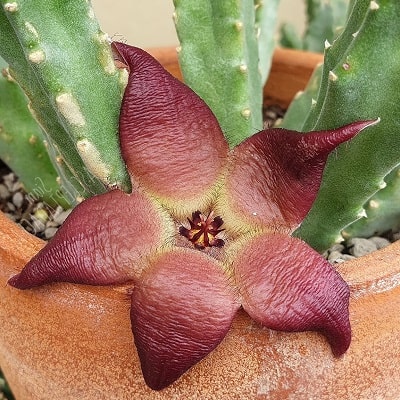
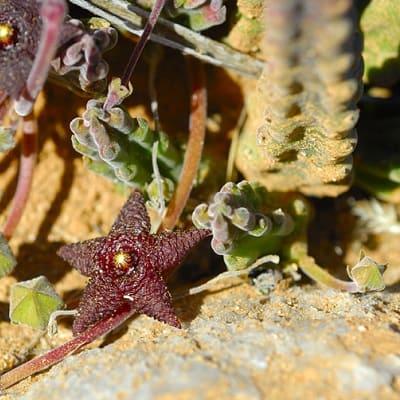
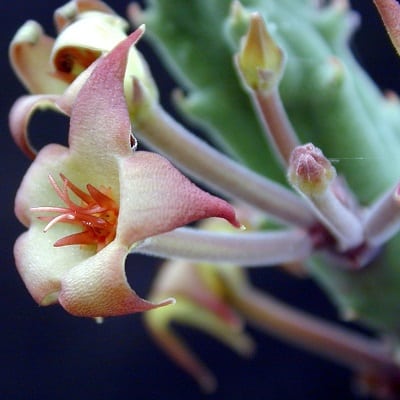
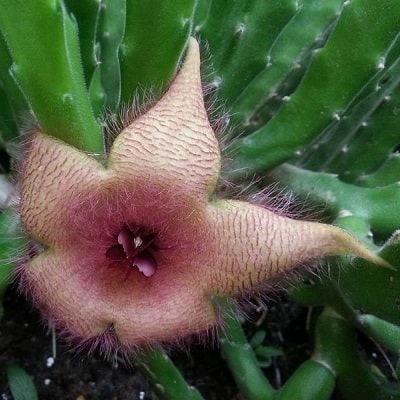
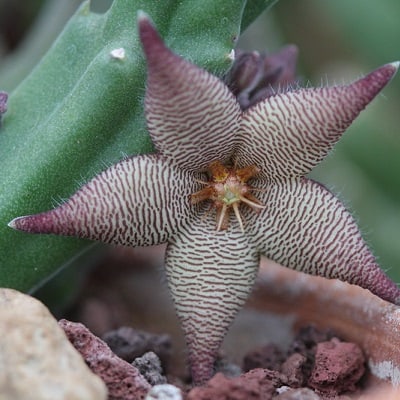
Related Post:
1,000 Types of Succulents With Pictures
Stapelia Species and Varieties
Let’s dive into the diverse world of Stapelia succulents and explore some of the fascinating species and varieties found within this unique plant family.
Stapelia clavicorona

First up is the impressive Stapelia clavicorona. This species boasts robust stems, which can range anywhere from 1 to 10 (and occasionally up to 100) in number. These stems are deeply indented between the angles, giving them a distinctive appearance. The star-shaped flowers of Stapelia clavicorona are relatively small, measuring around 50 to 60 mm in diameter. Prepare to be amazed by one of the most unusual flowers in the Stapelia genus!
Stapelia divaricata

Next, let’s meet the charming Stapelia divaricata. This small stapeliad stands at a height of 6 to 12 cm and features green-gray and reddish angular stems, about the thickness of a pencil (approximately 0.5 to 1 cm in diameter). The stems branch out and form tillers from the base, and the epidermis has a velvety texture. Keep an eye out for this delightful succulent!
Stapelia engleriana

The uncommon Stapelia engleriana catches the eye with its thick, divaricately branched stems, which can reach lengths of up to 30 cm. These stems have a soft pubescent texture and come in shades of gray-green or dark green. Their small spreading teeth contribute to their intriguing appearance. Unlike most other Stapelia species, the flowers of Stapelia engleriana appear from mid-stem upwards. They are characterized by their dark purple-brown or chocolate-colored hue and unique triangular corolla lobes that roll back completely, making the flowers resemble circular Turk’s caps. Keep an eye out for this distinctive plant!
Stapelia flavopurpurea

Prepare to be enchanted by the tufted beauty of Stapelia flavopurpurea. This cactus-like plant reaches a height of 10 cm and features wonderfully small-sized flowers with a diameter of only 3 cm. The flat, starfish-shaped flowers are adorned with eye-catching colors, ranging from yellow, green, orange, and purple to white, with maroon overtones. The center of the flower is white and covered with red claviform hairs, creating a truly bizarre and lovely color combination. Additionally, this species surprises with a light, sweet fragrance, reminiscent of licorice or honey. Keep an eye out for the captivating variety within this species!
Stapelia gariepensis

Let’s travel to Namaqualand, South Africa, where we’ll find the uncommon Stapelia gariepensis. This species showcases beautiful, large flowers with a diameter of approximately 10 cm. The flowers bear a striking red-brown hue and are covered in soft, hairy textures. In their natural habitat, the long stems of Stapelia gariepensis lie flat on the ground, adding an interesting element to its appearance.
Stapelia gettleffii

Stapelia gettleffii resembles a stem succulent closely resembling a cactus. Its velvety, spineless branches have a quadrangular cross-section and reach heights of up to 25 cm, with the potential to form big clumps up to 1 m in spread. The star-shaped flowers of Stapelia gettleffii are truly magnificent. With a diameter of about 15 cm, these flowers boast purple lines on a cream-colored background, accompanied by dense soil-purple hairs around the corona. The white ciliate margins add an extra touch of beauty. Keep an eye out for these stunning ground-level blooms!
Stapelia gigantea


As its name suggests, Stapelia gigantea is another stem succulent with a cactus-like appearance. The velvety, spineless branches have a quadrangular cross-section and can grow to heights of 10 to 30 cm. This species has the potential to form impressive clumps up to 1 m in spread. Keep an eye out for the unique growth pattern of Stapelia gigantea!
Stapelia glanduliflora

Stapelia glanduliflora is known for its distinctive star-shaped flowers, which are adorned with white glandular club-shaped hairs on the upper side. The name glanduliflora refers to the acorn-shaped appearance of the buds. Watch out for this peculiar yet handsome variety!
Stapelia grandiflora


Get ready to be amazed by the tufted beauty of Stapelia grandiflora. This cactus-like plant features large, showy starfish-shaped flowers that are sure to capture your attention. Stapelia grandiflora is a highly variable species, with many hybrids both in the wild and in cultivation. It often intergrades with Stapelia hirsuta, another similar species. Keep an eye out for its thicker pedicel, which distinguishes it from its close relative.
Stapelia hirsuta




Popularly known as African starfish flowers, Stapelia hirsuta stands out with its foul-smelling flowers. The flowers, typically 5 to 15 cm wide, bloom in the shape of a large star. Keep an eye out for these intriguing and pungent blooms!
Stapelia leendertziae

Stapelia leendertziae is a unique species that trails and hangs down over the pot, forming dense carpets or cushions up to 1 meter or more in diameter. Watch as this succulent fills your space with its trailing beauty.
Stapelia mutabilis

Stapelia mutabilis is a controversial name given to a hybrid that is believed to be a cross between Tromotriche revoluta (Stapelia revoluta) and Masson, resulting from cross-fertilization by insects. This hybrid displays various forms, differing slightly in coloration and the lobes of the outer corona. The flowers remain open for 4 to 7 days, showcasing their unique features. Keep an eye out for the striking variety within this hybrid!
Stapelia obducta

Watch as Stapelia obducta showcases its unique appearance. The corolla of this species, when flat, measures approximately 5 cm in diameter and is deeply lobed. As the flower matures, the corolla curls backward, creating an unusual sight reminiscent of a strange red animal. Keep an eye out for this intriguing species!
Stapelia olivacea

The uncommon Stapelia olivacea is a tufted species with stems reaching about 10 cm in height. This species features few-flowered basal inflorescences with small evil-scented flowers, ranging in color from reddish-yellow to olive-green, and sometimes even almost black. The flowers have transverse brown lines and minute flat non-vibratile hairs. Stapelia olivacea stands out with its erect, closely parallel grouping of thin, fuzzy gray stems. Keep an eye out for this striking succulent!
Stapelia paniculata


Say hello to the Small Starfish Flower, also known as Stapelia paniculata subsp. scitula. This adorable miniature version of the larger Stapelias is perfect for those looking for a compact plant. With slender, light green stems that measure no more than 7 mm across and reach a height of about 8 cm, this variety forms neat and charming clumps.
Despite its small stature, it surprises with proportionately diminutive star-shaped blooms, each measuring less than 2.5 cm across. These blooms come in magenta or dark chestnut-brown hues, sometimes with yellowish bands and densely covered in purple or maroon hairs. Furthermore, while it still carries a foul fragrance, it is delicate and not overpowering, making it a suitable houseplant. Don’t miss out on this cute and prolific species!
Stapelia rufa

Stapelia rufa is a tufted cactus-like plant that can reach heights of 100 to 220 mm. This species showcases small but showy starfish-shaped flowers with captivating dull, dark purple, dark red, or even yellow hues. The flowers appear randomly along the stem but mainly at the base of the four-cornered velvety branches. The corolla, transversely wrinkled and with a shallow depression at the center, features pointed lobes that are minutely ciliate at the edge and glabrous at the base, with pubescent tips. The combination of these features creates a unique and captivating sight. Keep an eye out for these enchanting blooms, which typically appear in spring!
Stapelia schinzii

Stapelia schinzii stands out with its handsome and highly curious star-shaped flowers adorned with hairs along the edges of the petals. These flowers, ranging in size from 10 to 20 cm in diameter, are relatively large compared to the stems. Stapelia schinzii is closely related to the threatened Stapelia pillansii and is known for its unique feature: clavate and strongly vibratile hairs that form a fringe along the edge of the corolla lobes. These hairs quiver even in the slightest breeze, potentially attracting insects. Keep an eye out for this fascinating phenomenon and the remarkable flowers of Stapelia schinzii!
Stapelia schinzii var. angolensis

Similar to Stapelia schinzii, Stapelia schinzii var. angolensis showcases dark red to maroon flowers with hairs along the edges of the petals. However, this variety presents smaller flowers, measuring only about 8 cm in diameter. The stems are more slender and scarcely toothed, with a creeping habit. Keep an eye out for the distinct traits of this variety!
Stapelia schinzii var. bergeriana

Stapelia schinzii var. bergeriana, formerly known as Stapelia bergeriana, is a robust clump-forming perennial succulent. This variety can spread up to 1 m, featuring stems arising from a short horizontal base. Stand in awe as the smooth and shiny corolla unfolds, characterized by wider, dull flesh-colored lobes that transition into a creamy white center. Once again, this variety boasts clavate and strongly vibratile hairs along the edge of the corolla lobes, providing a mesmerizing spectacle when they tremble even in a gentle breeze. Be sure to keep an eye out for this unique variety!
Stapelia similis

Stapelia similis is a tufted cactus-like plant with captivating dark purple starfish-shaped flowers. This species showcases considerable variation, both in the wild and in cultivation, making it a fascinating subject to explore. Stapelia similis shares a close resemblance with Stapelia kwebensis, Stapelia kwebensis var. longipedicellata, and Stapelia parvula, forming a closely related group. Keep an eye out for the intriguing varieties within this group!
Stapelia unicornis

Stapelia unicornis is a stem succulent that resembles a cactus. Its erect to decumbent branches, which are velvety, spineless, and have a quadrangular cross-section, cease growth when they reach a height of less than 15 cm. However, they have the potential to form stout clumps up to 1 m in spread.
The star-shaped flowers of Stapelia unicornis are ochreous yellow and measure approximately 100 mm in diameter. The spreading lobes display finely cross-striated raised reddish lines and are covered in silky hairs, with tapering and recurving tips. The bowl-shaped center of the flower further adds to its unique appearance. Keep an eye out for this fascinating species, which is immediately recognizable by its different inner corona lobes compared to its close relative, Stapelia gigantea.
Stapelia villetiae

Lastly, let’s appreciate the uncommon Stapelia villetiae. This South African species forms clumps of stems that reach a height of about 15 cm. Stapelia villetiae is known for its very handsome and highly curious star-shaped flowers, which measure around 6.5 cm across. These flowers flaunt blackish hues with transverse yellowish lines. The plants are large and robust, forming lax clumps that sometimes spread up to 50 cm or more. Keep an eye out for this striking succulent, which shares a close relationship with Stapelia cedrimontana.
How to Care for Stapelia
If you have a Stapelia succulent at home and want to keep it blooming, we’ve got you covered with some helpful tips. These plants are low-maintenance, so you don’t need to do much to keep them happy. Just follow a few simple steps, and you’ll be good to go!
Light
Stapelia succulents prefer shade rather than direct sunlight. So if you live in colder regions, you’re in luck. A winter temperature of around 50 degrees Fahrenheit is perfect for Stapelia plants.
Avoid placing the plant in a spot that receives excessive sunlight, as it can lead to sunburn. Partial shade is the ideal condition for the healthy growth of Stapelia succulents.
Watering
Pay attention to the plant’s signals to determine its watering needs. Watering should be infrequent, allowing the plant to dry out between watering sessions. Overwatering can be harmful.
During the winter months, water the plant even less and watch for signs of withering leaves. If the plant looks a bit shriveled, you can lightly mist it with water.
Soil
Delicate species of Stapelia thrive best in clay pots. Mix the soil with compost to provide proper nutrition for the plant. Mineral-based compost works well for Stapelia succulents, keeping them healthy and pest-free.
Fertilizing
Stapelia succulents do not require fertilizers. By providing the right amount of light and water and maintaining suitable soil conditions, your plant will thrive happily.
Pests and Diseases
Be cautious of mealy bugs, as they can attack Stapelia succulents. Keep an eye out for any stem damage caused by insects. Avoid overwatering, as it can lead to root rot and make the succulent vulnerable to bug infestations.
Periodically spray the plant with a high-quality insecticide to keep it healthy and thriving.
How to Propagate Stapelia?
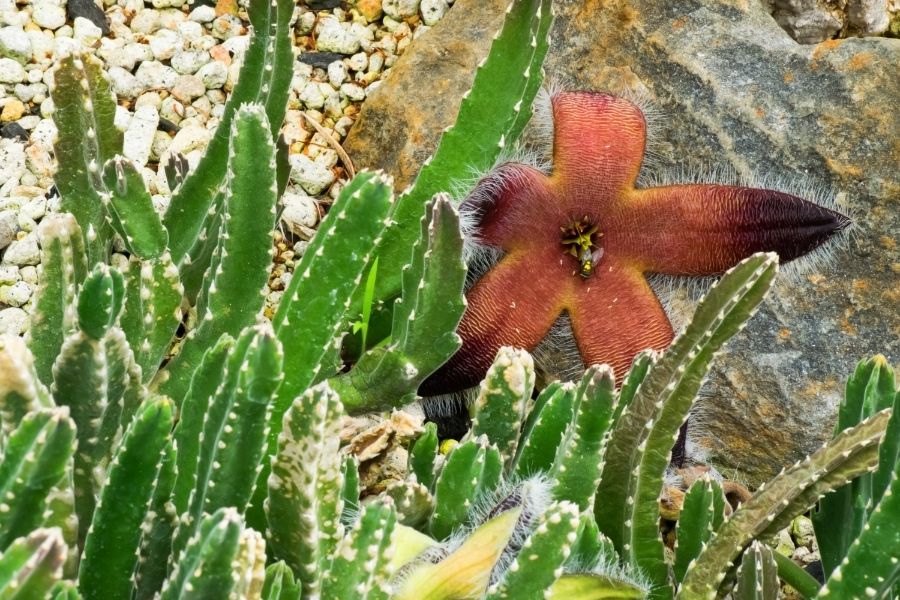
One of the reasons people love Stapelia succulents is because they are easy to propagate and maintain. This is great for those without a green thumb who still want to enjoy the beauty of these plants in their homes.
Propagating Stapelia from stem cuttings is ideal. Follow these steps for best results:
- Cut a stem from a mature Stapelia succulent.
- Let the stem dry for some time.
- Prepare a good potting mix while the stem dries. Once dry, plant the stem in the mix, ensuring it’s not buried too deep to avoid rot.
- Water the plant periodically and place it in indirect sunlight. Avoid overwatering newly propagated plants, as it can cause rot.
Some people also propagate Stapelia succulents from seeds, but stem propagation is more popular and effective.
It’s also a good idea to repot your Stapelia succulent once a year to prevent rot and bug infestations. While not necessary, it can be a beneficial practice. Choose a container with good drainage and aeration.
FAQs
Stapelia succulents are easy to grow and can bring beauty to your balcony or workplace. Here are some frequently asked questions about Stapelia succulents that you should know.
How Often Do Stapelia Bloom?
A baby Stapelia plant usually takes about two years to bloom. As it matures, you can expect more blooms and flowers. Meeting the plant’s lighting, watering, and soil needs plays a crucial role in its blooming frequency.
The better you meet its light and water requirements, the more abundant the blooming and flowering will be. Placing the plant in a damp environment, for example, can significantly affect flowering.
How Do You Get Stapelia to Flower?
Stapelia succulents flower when exposed to warm weather and bright, indirect sunlight. There’s nothing special you need to do. Just ensure proper watering and soil conditions in an appropriate container. Mastering the basics is the secret to getting Stapelia succulents to flower.
